Physical Address
304 North Cardinal St.
Dorchester Center, MA 02124
Epithelium and glands of the larynx arise from the endoderm lining the laryngotracheal groove.
Supraglottic larynx arises from the third and fourth branchial arches.
Glottis and subglottic larynx arise from the sixth branchial arch.
Cartilage, muscle, and other connective tissue elements develop from the mesenchyme around the foregut:
Thyroid, cricoid, arytenoid, corniculate, and cuneiform cartilages derived from the fourth and sixth branchial arch
Greater cornu and inferior part of the body of the hyoid bone derived from the third branchial arch cartilage; lesser cornu and superior part of the body of the hyoid bone derived from the second branchial arch cartilage
Intrinsic muscles of the larynx muscles derived from the fourth and sixth branchial arch
Superior laryngeal and recurrent laryngeal nerves (both branches of the vagus nerve) are derived from the fourth and sixth branchial arch.
Superior border:
Tip of epiglottis
Inferior border:
Inferior rim of the cricoid cartilage
Anterior border:
Lingual surface of epiglottis (vallecula), thyrohyoid membrane, anterior commissure, thyroid cartilage, cricothyroid membrane, and the anterior arch of the cricoid
Posterior border:
Posterior commissure, arytenoid and interarytenoid space, and the mucoperichondrium overlying the cricoid cartilage
Lateral border:
Aryepiglottic folds
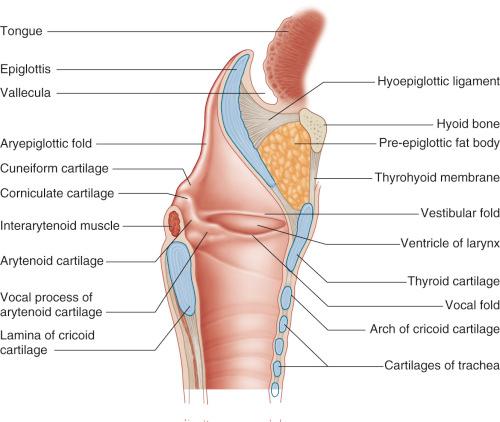
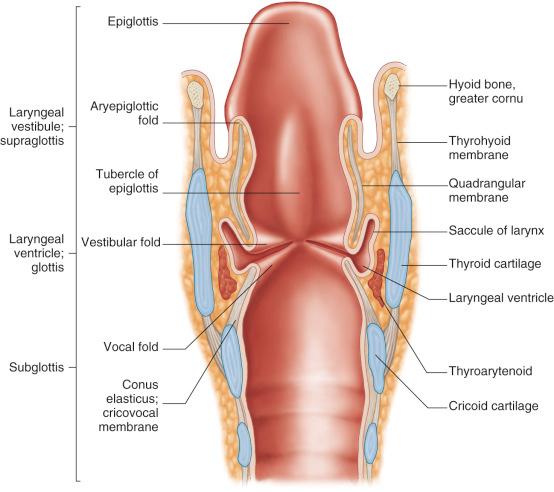
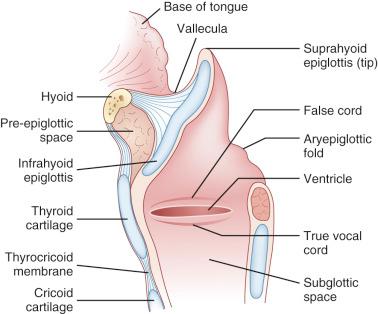
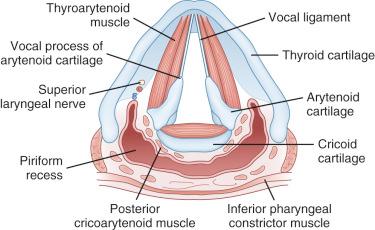
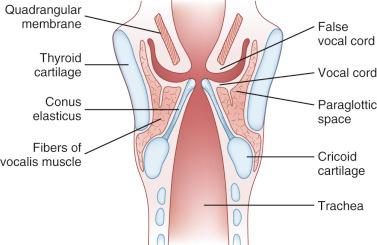
Supraglottis:
Extends from the tip of the epiglottis to a horizontal line passing through the apex of the ventricle
Structures in this compartment include:
Epiglottis (lingual and laryngeal aspects), aryepiglottic folds, arytenoids, false vocal cords, and ventricle
Supraglottic larynx arises from the third and fourth branchial arches.
Glottis:
Extends from the ventricle to approximately 0.5 to 1.0 cm below the free level of the true vocal cord and includes the anterior and posterior commissures and the true vocal cord:
Glottic portion of the larynx arises from the sixth branchial arch.
Subglottis:
Extends from approximately 0.5 to 1.0 cm below the level of the true vocal cord to the inferior rim of the cricoid cartilage:
Subglottic larynx arises from the sixth branchial arch.
Paralumenal spaces
Represent potential spaces that lie between the laryngeal cartilages and ligaments and membranes that support them
Three main paralumenal spaces include:
Pre-epiglottic space
Paraglottic space
Subglottic space
Pre-epiglottic space:
Not a space but represents a roughly triangular area lying anterior to the epiglottic cartilage that is filled with adipose tissue and loose connective tissue bounded:
Anteriorly by hyoid bone, thyroid cartilage, and thyrohyoid membrane
Posteriorly by epiglottic cartilage and thyrohyoid ligament
Superiorly by hypoepiglottic ligament forming the base
Contains lymphatics and blood vessels but no lymph nodes
Malignancies of laryngeal surface of the epiglottis may invade fat and areolar tissue of pre-epiglottic space.
Paraglottic space:
Not a space but represents an area deep to the true and false vocal cords that contains adipose tissue and loose connective tissue bounded:
Inferiorly by conus elasticus (i.e., cricovocal membrane)
Laterally by thyroid cartilage
Medially by quadrangular membrane
Posteriorly by piriform sinus
Superiorly is in continuity with pre-epiglottic space
Contains lymphatics and blood vessels but no lymph nodes
Supraglottic tumors may spread into paraglottic space and reach the subglottis or extend beyond the limits of the larynx.
Fixation of vocal cord represents good indicator of a tumor in the paraglottic space
Subglottic space:
Bounded:
Laterally by conus elasticus (i.e., cricovocal membrane)
Medially by mucosa of subglottic region
Superiorly by undersurface of Broyle's ligament
Continuous with inner surface of cricoid cartilage and its mucosa
Broyle's ligament:
Site where vocal fold meets anteriorly (known as anterior commissure) and is region where fibers of vocal ligament pass through thyroid cartilage to blend with overlying perichondrium forming Broyle's ligament
Broyle's ligament contains blood vessels and lymphatics, representing potential route for escape of malignant tumors of the larynx.
Laryngeal cartilage ( Fig. 14-6 )
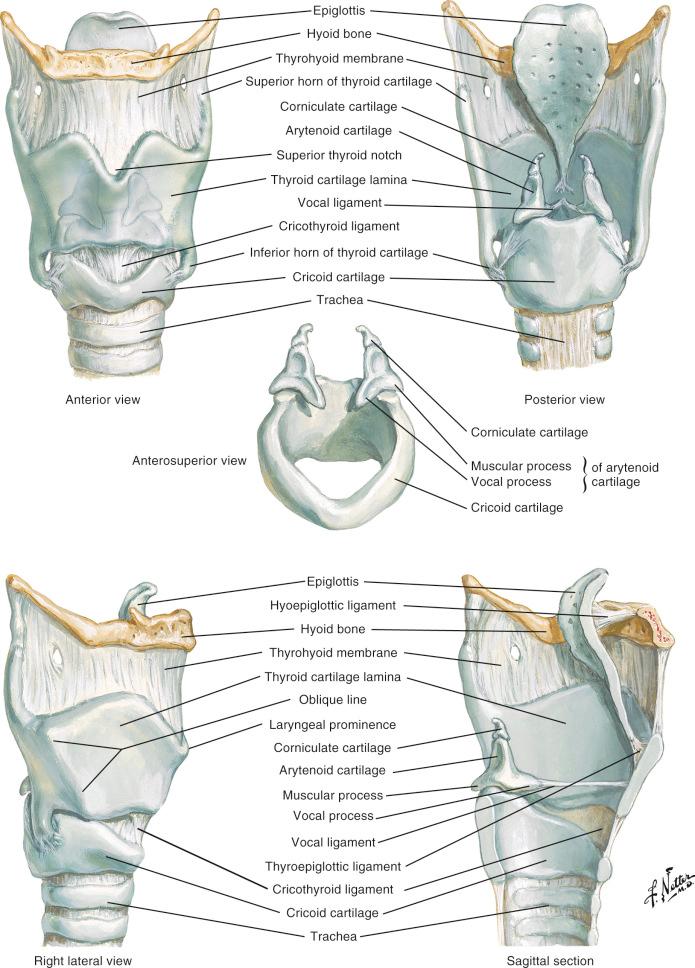
Skeleton of larynx composed of cartilage, fibrous sheets, and bands; attached muscles adjust position of cartilages, changing shape and tension of vocal cords
Thyroid cartilage:
Largest of the laryngeal cartilage
Double-winged
Cricoid cartilage:
Only complete ring in respiratory system
Represents foundation of larynx
Resembles signet ring with larger part facing posteriorly
Arytenoid cartilage:
Paired cartilage perched on superior edge of cricoid cartilage
Each cartilage is pyramidal.
At inferior aspect are two projections:
Muscular process on posterolateral margin
Vocal process located anteriorly
Vocal ligament attaches to vocal process of arytenoid cartilage.
Superior process represents apex of pyramid:
Corniculate cartilage rests on the margin of the superior process of the arytenoid cartilage.
Articulations between the various laryngeal joints are synovial and may be involved by an arthritic process.
Become a Clinical Tree membership for Full access and enjoy Unlimited articles
If you are a member. Log in here